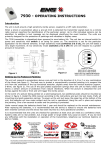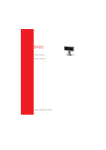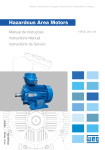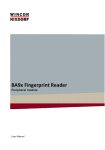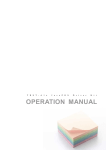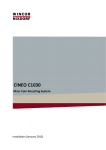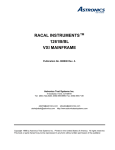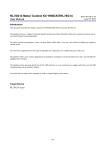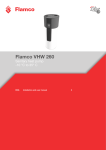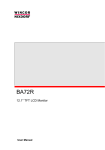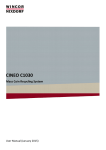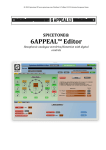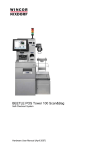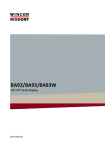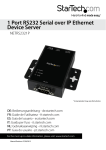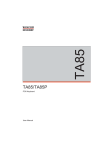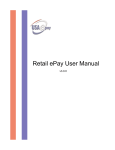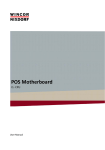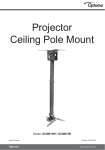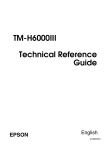Download - Wincor Nixdorf
Transcript
BA64 Customer Display User Manual We would like to know your opinion on this publication. Please send us a copy of this page if you have any constructive criticism. We would like to thank you in advance for your comments. With kind regards, Your opinion: Wincor Nixdorf Pte Ltd Research and Development 151 Lorong Chuan New Tech Park #05-01A/B Sinagpore 556741 E-Mail: retail.documentation@wincor-nixdorf.com Order No.: 01750281000 B BA64 Customer Display User Manual Edition December 2015 All brand and product names mentioned in this document are trademarks of their respective owners. Copyright ©Wincor Nixdorf International GmbH, 2015 The reproduction, transmission or use of this document or its contents is not permitted without express authority. Offenders will be liable for damages. All rights, including rights created by patent grant or registration of a utility model or design, are reserved. Delivery subject to availability; technical modifications possible. Contents About This Manual......................................................................... 1 Introduction ................................................................................... 2 Features at a glance ........................................................................ 2 Manufacturer´s Certification .......................................................... 3 FCC-Class A Declaration .................................................................. 3 Care of BA64 .................................................................................. 4 Recycling BA64 ............................................................................... 5 Warranty........................................................................................ 6 Overview ....................................................................................... 7 BA64 on a stand.............................................................................. 7 BA64 on a pole ............................................................................... 7 BA64 on a BA9x display ................................................................... 8 BA64 on a BEETLE iPOS system....................................................... 8 Initial setup .................................................................................... 9 Unpacking And Checking the Delivery Unit...................................... 9 Mounting options and connection cables ........................................ 9 BA64 Installation .......................................................................... 13 lnstalling the BA64 to a stand ................................................... 13 lnstalling the BA64 to a pole ..................................................... 16 lnstalling BA64 on BA9x display ................................................ 19 lnstalling BA64 on BEETLE iPOS plus Advanced system .............. 23 Display Characteristics ................................................................. 27 Screen Coordinates....................................................................... 27 Cursor Behaviour .......................................................................... 28 Display Commands....................................................................... 29 Control Characters and ESC Sequences ......................................... 29 Backspace ................................................................................ 31 Line Feed.................................................................................. 32 Carriage Return ........................................................................ 32 Delete To End of Line................................................................ 33 Clear Screen ............................................................................. 33 Set Cursor Position ................................................................... 33 Set Country Code ..................................................................... 35 Select Character Size ................................................................ 37 Select Character Resolution ...................................................... 38 Dump User Defined Picture to Screen ....................................... 39 Set Clock .................................................................................. 40 Set Watch Dog of Cable Monitor ............................................... 41 Load User Logo and Set Display Monitor ................................... 41 Turn Display On And Off ........................................................... 42 Select Line Mode ...................................................................... 43 Display Identification ................................................................ 44 Character Set Identification ...................................................... 45 Firmware Identification ............................................................ 46 Set Compatibility Mode ............................................................ 47 Read Current Compatibility Mode............................................. 48 Set baud rate for serial port ...................................................... 49 Set baud rate for serial port (alternate command) .................... 51 Set Character Encode/Decode Mode ........................................ 52 Read Character Encode/Decode Mode...................................... 53 Start Self-test ........................................................................... 54 Restore Configuration Data to Factory Default .......................... 54 ESC/POS Command ....................................................................... 55 Supported Commands .............................................................. 55 Unsupported Commands .......................................................... 57 USB Command.......................................................................... 59 Command Format..................................................................... 59 Write Data................................................................................ 60 Request Status ......................................................................... 60 Reset ........................................................................................ 61 Read Display Identification ....................................................... 61 Read Character Set Identification .............................................. 62 Read Firmware Identification .................................................... 63 Read Display Compatibility Mode ............................................. 64 Read Character Encode/Decode................................................ 65 Request Self-Test ...................................................................... 66 Restore Factory Default ............................................................ 66 Status Bytes Definitions ............................................................ 67 Middleware .............................................................................. 68 Firmware Updates ........................................................................ 69 Supported Codepages .................................................................. 70 Technical Data.............................................................................. 72 Dimensions................................................................................... 73 BA64 ........................................................................................ 73 BA64 installed on a stand ......................................................... 74 BA64 installed on a pole ........................................................... 74 BA64 installed on a BA92 display .............................................. 75 BA64 installed on a BA93 display .............................................. 75 BA64 installed on a BA93W display ........................................... 76 BA64 installed on a BEETLE iPOS system ................................... 76 Abbreviation Index ...................................................................... 77 About This Manual This documentation is intended to help you to work with the customer display and to serve as a reference work. The detailed table of contents help you find the desired information quickly and easily. Notes in the manual are marked by this symbol. This symbol is used for warnings. BA64 customer display user manual 1 Introduction The BA64 family of Line Displays is available in two display technologies, VFD and FSTN LCD, respectively called BA64-2 and BA64-G. The BA64-2 is 2 rows x 20 characters of 5x7 character matrix whereas the BA64-G is 4 rows x 30 characters of 8x16. With a bigger character matrix and the graphical nature of the display module, the BA64-G is capable of displaying Asian characters and characters with complex strokes. There is an option of USB or powered COM connection to the POS terminal simply by using the respective cable options. To support a variety of usage scenarios, the BA64 is offered with different mounting options. The desktop stand, pole mounting, and adapters for mounting to the BA9x or the iPOS plus Advanced are available in addition to a VESA compatible mounting pattern on the unit itself. Features at a glance VFD and LCD version allow for worldwide application Character based display for international code pages Epson ESC POS command set support Unicode support JavaPOS 1.13 support Flexible mounting options thanks to VESA 20x50 mounting pattern Small footprint 2 BA64 customer display user manual Manufacturer´s Certification The device complies with the requirements of the EEC directive 2004/108/EC with regard to ‘Electromagnetic compatibility" and 2006/95/EC “Low Voltage Directive” and RoHS directive 2011/65/EU. Therefore, you will find the CE mark on the device or packaging. FCC-Class A Declaration This equipment has been tested and found to comply with the limits for a Class A digital device, pursuant to part 15 of the FCC Rules. These limits are designed to provide reasonable protection against harmful interference when the equipment is operated in a commercial environment. This equipment generates, uses, and can radiate radio frequency energy and, if not installed and used in accordance with the instruction manual, may cause harmful interference to radio communications. Operation of this equipment in a residential area is likely to cause harmful interference in which case the user will be required to correct the interference at his own expense. Modifications not authorized by the manufacturer may void users authority to operate this device. This class A digital apparatus complies with Canadian ICES-003. Cet appareil numerique de la classe A est conforme à la norme NMB-003 du Canada. BA64 customer display user manual 3 Care of BA64 Clean your customer display regularly with an appropriate surface cleaning product. Make sure that the device is switched off and that no moisture is allowed to get into the inside of the device. 4 BA64 customer display user manual Recycling BA64 Environmental protection does not begin when the time has come to dispose of the BA64; it begins with the manufacturer. This product was designed according to our internal norm “Environmental conscious product design and development”. The BA64 is manufactured without the use of CFC and CHC and is produced mainly from reusable components and materials. The processed plastics can, for most part, be recycled. Even the precious metals can be recovered, thus saving energy and costly raw materials. Please do not stick labels onto plastic case parts. This would help us to reuse components and material. But there are still some parts that are not reusable. Wincor Nixdorf guarantees the environmentally safe disposal of these parts in a Recycling Center, which is certified pursuant to ISO 9001 and ISO 14001. Please contact your competent branch office for information on how to return and reuse devices and disposable materials. BA64 customer display user manual 5 Warranty Wincor Nixdorf guarantees generally a warranty engagement for 12 months beginning with the date of delivery. This warranty engagement covers all those damages which occur despite a normal use of the product. Damages due to improper or insufficient maintenance, improper use of the product or unauthorized modifications of the product, inadequate location or surroundings will not be covered by the warranty. All parts of the product which are subject to wear and tear are not included in the warranty engagement. For detailed warranty arrangements please consult your contract documents. Please order spare parts at the Wincor Nixdorf customer service. 6 BA64 customer display user manual Overview Below, you will find reference pictures showing the BA64 in different mounting scenarios. Installation components, like e.g. the pole itself, are not part of the BA64 delivery. The pictures might deviate in details from the product you received. BA64 on a stand BA64 on a pole BA64 customer display user manual 7 BA64 on a BA9x display BA64 on a BEETLE iPOS system 8 BA64 customer display user manual Initial setup This chapter provides you with the information you need to prepare for the installation of the system. Unpacking and Checking the Delivery Unit Unpack the parts and check to see whether the delivery matches the information on the delivery note. The delivery comprises the respective screen module. Mounting adapters can be ordered separately based on the intended installation scenario. Data cables, necessary for operation, can be ordered separately. lf damage has occurred during shipping or if the package contents do not match the delivery note, immediately inform your Wincor Nixdorf sales outlet. Transport the device only in its original packaging (to protect it against impact and shock). Mounting options and connection cables Different mounting options and connection cables are available to install the BA64 in the various installation scenarios. Mounting options and cables have to be purchased separately from the main unit. The list below shows an overview of the BA64 configuration components and their detailed content. BA64 VFD display with silver housing consists of: 1 x BA64 VFD display with silver housing 4 x Torx Screw M4x6 with Black Zinc BA64 customer display user manual 9 BA64 VFD display with black housing consists of: 1 x BA64 VFD display with black housing 4 x Torx Screw M4x6 with Black Zinc BA64 LCD display with silver housing consists of: 1 x BA64 LCD display with silver housing 4 x Torx Screw M4x6 with Black Zinc BA64 LCD display with black housing consists of: 1 x BA64 LCD with black housing 4 x Torx Screw M4x6 with Black Zinc Stand consists of: 1 x Stand BA64 assembly 10 BA64 customer display user manual Pole mount adapter consists of: 1 x Pole mount adapter BA64 assembly BA9x dual display adapter for BA64 consists of: 1 x Adapter Hinge 1 x Bracket 2 x Torx Pan Head Screw M3x10 Black Zinc BA64 customer display user manual 11 BEETLE iPOS plus dual display adapter for BA64 consists of: 1 x Adapter Hinge 1 x Bracket 2 x Torx Pan Head Screw M3x10 Black Zinc Connection cables: You will need to use either one of these cables to connect the BA64 to the main system. RJ45 to USB connection cable RJ45 to RS232 connection cable 12 BA64 customer display user manual BA64 Installation lnstalling the BA64 to a stand You will need the following parts to install a BA64 to a stand: 1 x BA64 1 x Stand 1 x Connection cable BA64 customer display user manual 13 Steps to install 14 1. Thread the end of the connection cable with RJ45 through the stand. 2. Connect the RJ45 connector to BA64. 3. Secure the cable in the strain relief at the back of BA64. BA64 customer display user manual BA64 customer display user manual 4. Secure BA64 to the stand with two M4x6 screws provided in the BA64. 5. Secure the cable in the strain relief at the base of the stand. 6. The installation is complete. 15 lnstalling the BA64 to a pole You will need the following parts to install a BA64 to a pole: 1 x BA64 1 x Pole mount adapter 1 x Connection cable 16 BA64 customer display user manual Steps to install 1. Thread the end of the connection cable with RJ45 through the pole and the pole mount adapter. Match the pole mount adapter and the pole1 together. 1 2. Connect the RJ45 connector to BA64. 3. Secure the cable in the strain relief provided in the BA64. The shown pole is for reference only and not part of the product delivery BA64 customer display user manual 17 4. Secure BA64 to the pole mount adapter with two M4x6 screws provided in the BA64. 5. Locate the screw hole on 2 the pole . Use a M3 screw to secure the BA64 and pole mount adapter assembly to the pole. The installation is complete. 2 The shown pole is for reference only and not part of the product delivery 18 BA64 customer display user manual lnstalling BA64 on BA9x display You will need the following parts to install a BA64 on a BA9x display: 1 x BA64 1 x BA9x dual display adapter for BA64 1 x Connection cable BA64 customer display user manual 19 Steps to install 1. Remove all the covers from the stand of BA9x display and the two top screws (1) and (2) from the bracket. Thread the end of the connection cable with RJ45 through the stand. 2. 20 Slide in the bracket, fix back the two screws removed in step 1 and tighten to secure. BA64 customer display user manual 3. Thread the end of the connection cable with RJ45 through the adapter hinge. Connect the RJ45 connector to BA64. BA64 customer display user manual 4. Secure the cable in the strain relief provided in the BA64. 5. Secure BA64 to the hinge adapter with two M4x6 screws provided in the BA64. 21 6. Place the BA64 and hinge adapter assembly on the BA9x display 7. Secure the BA64 and hinge adapter assembly to the BA9x display with two M3x10 screws provided in the adapter kit. The installation is complete 22 BA64 customer display user manual lnstalling BA64 on BEETLE iPOS plus Advanced system You will need the following parts to install a BA64 on a BA9x BEETLE iPOS plus Advanced system: 1 x BA64 1 x BEETLE iPOS plus Advanced dual display adapter for BA64 1 x Connection cable BA64 customer display user manual 23 Steps to install 1. Remove all the covers from the stand of BEETLE iPOS plus Advanced system and the two top screws (1) and (2) from the bracket. Thread the end of the connection cable with RJ45 through the stand. 2. 24 Slide in the bracket, fix back the two screws removed in step 1 and tighten to secure. BA64 customer display user manual 3. Thread the end of the connection cable with RJ45 through the adapter hinge. Connect the RJ45 connector to BA64. BA64 customer display user manual 4. Secure the cable in the strain relief provided in the BA64. 5. Secure BA64 to the hinge adapter with two M4x6 screws provided in the BA64 25 6. Place the BA64 and hinge adapter assembly on the BEETLE iPOS plus Advanced system. 7. Secure the BA64 and hinge adapter assembly to the BEETLE iPOS plus Advanced system with two M3x10 screws provided in the adapter kit. The installation is complete 26 BA64 customer display user manual Display Characteristics Screen Coordinates BA64-G is a graphical display of 240 x 64 resolution, the screen is divided into 4 rows and 30 columns to form a basic cell size of 8 pixels width and 16 pixels tall 1 30 1 2 3 4 BA64-2 is a text display of 2 rows by 20 characters, each character has a resolution of 5 pixels width and 7 pixels height. 1 20 1 2 The origin of the coordinate system is at the top-left corner of the screen as shown above. BA64 customer display user manual 27 Cursor Behaviour Cursor position depends on whether the writing system is left-to-right or right-to-left. In left to right writing system the cursor, represented by a black vertical bar, is on the left of the basic cell. In the example below, cursor position is at row 1 column 5. As characters are displayed the cursor moves towards the right, the movement is one or two cells depending on the width of the character. And in a right-to-left writing system the cursor is on the right side of the basic cell. As characters are displayed the cursor moves towards the left, the movement is one or two cells depending on the width of the character. An example of right-to-left writing system is the Arabic characters. The origin of the screen coordinate system depends on the Character Encoding/Decoding Mode, if in ASCII, the origin is at the top-right corner and if Unicode Mode is on the top-left corner. 28 BA64 customer display user manual Display Commands Control Characters and ESC Sequences Command Description BA64-2 BA64-G The table below is a summary of the Wincor’s control characters and escape sequences supported by the BA64-2 and BA64-G. BS Backspace LF Line Feed CR Carriage Return ESC [ 0 K Delete To End of Line ESC [ 2 J Clear Screen ESC [ <y> ; <x> H Set Cursor Position ESC R <n> Set Country Code ESC [ <n> ; <m> Z Set Character Size X ESC [ <n> B Set Character Resolution X ESC [ <n> I Set Line Mode X ESC [ 0 c Call display identification ESC [ 1 c Character Set Identification ESC [ 2 c Firmware Identification ESC [ <n> ; <m> S Set baud rate for serial interface ESC [ <y> ; <x> D <w> <d> Dump User-defined image to display X ESC [ <m> T Set Watchdog of cable monitor X BA64 customer display user manual 29 Command Description BA64-2 BA64-G ESC [ <n> L Load User Logo and Set Display monitor X ESC [ <h> ; <m> T Set Clock X ESC [ <n> P Switch ON/OFF backlight X ESC [ <n> E Set Display Mode ESC [ E Read Current Display Mode ESC [ <n> u Set Character encoding/decoding Mode ESC [ u Read Character encoding/decoding Mode ESC [ 0 ? Execute self-test Legends: Supported X Not Supported 30 BA64 customer display user manual Backspace Code Hexadecimal BS 08 Description: This command moves the cursor one position to the left. If there is a character in the position to which the cursor moves, it is not deleted. This command is ignored if the cursor is already at the first position of the row. Notes: 1. For BA64-2, the cursor remains at the same position if it reaches the first column of the row. 2. For BA64-G when in BA63G Compatible Mode, the behavior of this command is as follow: Move the cursor one column to the left. If cursor is currently on the column 1 and row 1 it remains at the current position, however, if cursor is currently not on row 1, move to the last column of the row above. The movement of the cursor by the backspace control character is not affected by the current Character Resolution/Size, the cursor always move the distance of one basic cell width or height. BA64 customer display user manual 31 Line Feed Code Hexadecimal LF 0A Description: This command moves the cursor one row down; the column position of the cursor remains unchanged. If the cursor is on the last row the screen scrolls up a row and the position of the cursor remains unchanged. Notes: 1. For BA64-G when in BA63G Compatible Mode, the behavior of this command is as follow: Increment the row number by 1 if the current Character Resolution/Size is normal height or increment by 2 if it is double height. If the new cursor position ends up on the last row (row 4) and if current Character Resolution/Size is double height, scroll up one row, the final cursor position shall be on row 3. Carriage Return Code Hexadecimal CR 0D Description: This command moves the cursor to the beginning of the row in which it is currently positioned. This command is ignored if the cursor is already at the beginning of the row. Notes: None 32 BA64 customer display user manual Delete To End of Line Code Hexadecimal ESC ‘[‘ ‘0’ ‘K’ 1B 5B 30 4B Description: This command deletes the characters from the cursor, including the cursor position to the end of the row. The position of the cursor remains unchanged. Notes: 1. For BA64-G when in BA63G Compatible Mode, it deletes the current row starting from the current cursor position regardless of the current settings for Character Resolution/Size or Line Mode. Clear Screen Code Hexadecimal ESC ‘[‘ ‘2’ ‘J’ 1B 5B 32 4A Description: This command clears all content on the screen. The cursor position remains unchanged. Notes: None Set Cursor Position Code Hexadecimal ESC ‘[‘ <y> ‘;’ <x> ‘H’ 1B 5B <y> 3B <x> 48 Description: This command positions the cursor to specified basic cell position. The cursor is not visible. Parameter <y> and <x> are 1 and 2 ASCII decimal numbers respectively. If <y> or <x> is 0, it is interpreted as 1, and if they BA64 customer display user manual 33 are greater than the maximum column or row it is interpreted as the maximum. If <y>, <x> and the ';' in between are omitted, the cursor is located at home position, i.e. coordinate (1, 1). Cursor coordinate of BA64-G always refer to the basic cell regardless of the current Character Resolution/Size or Line Mode. Notes: 1. Default position of cursor is (1, 1). 2. For BA64-2, valid ranges of value are 1 to 2 for <y> and 1 to 20 for <x>. 3. For BA64-G when in BA63G Compatible Mode, the behavior of this command is as follow: If Line Mode is 1 (2-line mode), meaning 2-line mode, the physical row number is calculated using the equation, row = y * 2 – 1. Therefore in 2-line mode, cursor position is row 1 if <y> is 1, and is row 3 if <y> is 2. 34 BA64 customer display user manual Set Country Code Code Hexadecimal ESC ‘R’ <n> 1B 52 <n> where <n> is a hexadecimal byte value that represents the country code. The supported country codes are listed below: Country Code Code page Character Set Country Code Code page Character Set 00 - USA 37 862 Latin/Hebrew 01 - France 38 IBM813 Latin/Greek 2 02 - Germany 39 775 Baltic Rim 03 - Great Britain 3A 855 Cyrillic 04 - Denmark 1 3B 860 Portuguese 05 - Sweden 3C 861 Icelandic 06 - Italy 07 - Spain 3E 863 French/Canada 08 - Japan 40 865 Nordic 09 - Norway 41 869 Greek 2 0A - Denmark 2 42 1250 Latin 2 Central Europe 0B - Spain 2 44 1251 Cyrillic Slavic 0C - Latin-America 45 1252 Latin 1 ANSI 30 437 Standard 46 1253 Greek 31 850 Latin 1 47 1254 Latin 5 Turkish 32 852 Latin 2 48 1255 Hebrew 33 857 Latin 5/Turkey 49 1257 Baltic Rim 34 858 Latin 1 4A 1258 Vietnamese 35 866 Latin/Cyrillic 36 737 Latin/Greek 2 63 897 Katakana The following country codes are applicable to BA64-G only. BA64 customer display user manual 35 Country Code Code page Character Set 43 1256 Arabic 80 932 Shift JIS 90 936 GB Jianti 92 950 BIG 5 93 950 BIG5+HKCS A0 949 Korean B0 874 Thai 4-level (8x19) B1 874 Thai 4-level (12x32) Description: This command set the specific character set for the respective country code defined by parameter <n> as shown above. Notes: 1. <n> is a hexadecimal byte. 2. The default is USA character set (n = 0) 3. This command is not supported in UTF-8 and UTF-16 modes. 36 BA64 customer display user manual Select Character Size Code Hexadecimal ESC ’[‘ <n> ‘;’ <m> ’Z’ 1B 5B <n> 3B <m> 5A Description: This command selects the size of character. After sending this command, all subsequent characters sent will be displayed in the selected width and height. The parameter <n> and <m> are one ASCII decimal number each and are used to specify the width and height of characters respectively. Currently, the valid values of <n> and <m> are: n m Double Byte Characters (WH) Single Byte Characters (WH) 1 1 16 16 8 16 1 2 2 2 1 2 16 32 32 x 16 32 32 8 32 16 x 16 16 32 The width of single byte character is half of the width of double byte character. When displaying double height character, a line feed command moves the cursor 2 lines down instead of 1 line. In this case, if the movement positions the cursor out of the screen, the screen scrolls the whole screen 2 lines up and with the cursor remaining at the same location. Notes: 1. Applicable to BA64-G only. 2. The default value of both <n> and <m> are 1. BA64 customer display user manual 37 Select Character Resolution Code Hexadecimal ESC ’[‘ <n> ’B’ 1B 5B <n> 42 Description: This command selects the resolution of character. After sending this command, all characters sent will be displayed in the selected resolution. The parameter n is one ASCII decimal number and is used to specify the width and height of a character in terms of pixel. The valid values of n are: N Double Byte Characters (WH) Single Byte Characters (WH) 0 16 16 8 16 1 16 32 8 32 2 32 32 16 32 The width of single byte character is half of the width of double byte character. When displaying double height character (i.e. n=1 or 2), a line feed command moves the cursor 2 lines down instead of 1 line. In this case, if the movement positions the cursor out of the screen, the device scrolls the whole screen 2 lines up and with the cursor remaining at the same location. Notes: 1. Applicable to BA64-G only. 2. When in BA63G Compatible Mode, the displayable characters following this command will be displayed from the current cursor position at the specified character resolution. And a line feed control character moves the cursor down by two rows if selected Character Resolution is double-height. 3. The default value of <n> is 0. 38 BA64 customer display user manual Dump User Defined Picture to Screen Code Hexadecimal ESC ’[‘ <x> ‘;’ <y> ’D’ <w> <h> <data> 1B 5B <x> 3B <y> 44 <w> <h> <data> where: <y> & <x> are ASCII coded decimal for the coordinates of the origin of the image. <w> is a byte value for the width of the image in byte (group of 8 pixels) <h> is a byte value for the height of the image in pixel. Description: This command dumps a user supplied image onto the display screen. The screen is organized into 64-pixel lines (y-axis) each lines has 30 bytes where the 8 bits of each byte is mapped to a pixel, the leftmost pixel is the most significant bit of the byte. The bytes in the <data> block are arranged sequentially by rows starting with from the upper left corner of the image. Below is a graphical representation of the screen where the values each box is the coordinate of a group of 8 pixels mapped horizontally. The valid range of <x> is 1 to 30, and <y> is 1 to 64. 1;1 2;1 : : 8;1 1;2 2;2 : : 8;2 1;3 2;3 : : 8;2 : 64;1 : 64;2 : 64;3 .... .... .... .... .... .... .... .... .... 1;29 2;29 : : 1;30 2;30 : : : : 64;30 Each byte in the y-coordinate consists of 8 bits each representing a pixel and oriented vertically where the LSB is mapped to the top of the group of 8 pixels. Notes: 1. The height of the image must be a multiple of 8 pixels. 2. Applicable to BA64-G only. BA64 customer display user manual 39 Set Clock Code Hexadecimal ESC ’[‘ <h> ‘;’ <m> ’T’ 1B 5B <h> 3B <m> 54 Description: This command is used to initialize the clock. Parameter <h> and <m> are one or two ASCII code decimal number Once this command is executed, the screen will display current time which is updated every one minute. It will also display a picture of the WN BEETLE with a pair of eyes that move every one second. This will continue until any command or character is sent to the display. Notes: 1. The clock will keep the time until the next set clock command or system power down. 2. Applicable to BA64-G only. 40 BA64 customer display user manual Set Watch Dog of Cable Monitor Code Hexadecimal ESC ’[‘ <m> ’T’ 1B 5B <m> 54 Description: This command defines time period of cable monitor. There is a cable monitor that monitors the signal on the RS-232 and USB line. If nothing appears on the cable for certain duration, the monitor will turn on the clock automatically. Cable monitor can be disabled by setting mm to 0. Notes: 1. The default value of <m> is 0. 2. Applicable to BA64-G only. Load User Logo and Set Display Monitor Code Hexadecimal ESC ’[‘ <n> ’L’ <data> 1B 5B <n> 4C <data> Description: This command loads a user defined logo that is to be displayed on the screen. The bitmap bytes of the logo must follow immediately after the command. The number of bytes must 240 (width in pixel) by 8 (height in byte) which fill the whole screen. The most significant bit of a data byte represents the left pixel. The bitmap data are sent from left to right, line by line. The user defined logo will be displayed automatically after the cable idle for a certain period, parameter <n> specifies this period in minute. It will not appear if <n> is set to 0. If the time periods of display clock and display user logo are the same, clock will never be displayed. Notes: 1. The default value of n is 0. 2. Applicable to BA64-G only. BA64 customer display user manual 41 Turn Display On And Off Code Hexadecimal ESC ’[‘ <n> ’P’ 1B 5B <n> 50 where n = 0 means OFF (default) = 1 means ON Description: This command turns off or on the display illumination. When the display is turned on, the device will turn on the illumination automatically whenever it receives command or character from the communication cable. Notes: 1. The default status of display is on (n = 1). 2. Applicable to BA64-G only. 42 BA64 customer display user manual Select Line Mode Code Hexadecimal ESC ’[‘ <n> ’I’ 1B 5B <n> 49 Description: This command selects the cursor positioning as either 4-line mode or 2line mode. <n> is a ASCII coded decimal number where, n = 0 means 4-line mode. = 1 means 2-line mode Notes: 1. Applicable to BA64-G only. 2. The default value of n is 0. 3. When in BA63G Compatible Mode, set Line Mode only affect the Set Cursor Position command, please read Set Cursor Position command for the details. Note, however, that the screen area of the BA64-G is still divided into 4 rows regardless of the Line Mode. BA64 customer display user manual 43 Display Identification Code Hexadecimal ESC’[‘’0’’c’ 1B 5B 30 63 Description: This command returns the display characteristics. Response: Code Hexadecimal ESC [ ? <p1>;<p2>;<p3>;<p4>;<p5> c 1B 5B 3F p1 3B p2 3B p3 3B p4 3B p5 63 where: BA64-2 BA64-G 3 = LCD p1 Type of display 2 = VFD p2 Firmware version One or more ASCII coded decimal number p3 Character set Two ASCII coded alphanumeric characters of the currently selected country code. If country code is not defined for the current codepage p3 shall be empty p4 Number of rows 2 2, 3 or 4 p5 Column/line 20 30 Notes: 1. This command is not supported in USB mode. 44 BA64 customer display user manual Character Set Identification Code Hexadecimal ESC ’[‘ ’1’ ’c’ 1B 5B 31 63 Description: This command returns the country code of the external character sets currently installed. Response: Code Hexadecimal ESC [ ? <cp1>;<cc1>;<cp2>;<cc2> … ; <cpn>;<ccn> c 1B 5B 3F cp1 3B cc1 3B … 3B cpn 3B ccn 63 Where cp1, cp2, … and cc1, cc2, … are the code pages and country codes respectively. Notes: 1. This command is not supported in USB mode. BA64 customer display user manual 45 Firmware Identification Code Hexadecimal ESC ’[‘ ’2’ ’c’ 1B 5B 32 63 Description: This command returns the boot and main firmware versions numbers. Response: Code Hexadecimal ESC [ ? <p1> <p2>;<p3> <p4> c 1B 5B 3F p1 p2 3B p3 p4 63 Where, p1, p2 are the boot firmware version and subversion number. p3, p4 are the main firmware version and subversion number. Notes: 1. This command is not supported in USB mode. 46 BA64 customer display user manual Set Compatibility Mode Code Hexadecimal ESC ’[‘ <n> ’E’ 1B 5B <n> 45 n is a ASCII coded decimal number defined as follow: n Display Mode 1 Set BA63G or BA63 Compatible mode (default) 2 Set ESC/POS Compatible mode Description: This command is to switch to the selected compatible mode. Sending this command will change the setting and save to flash (non-volatile). Notes: BA64 customer display user manual 47 Read Current Compatibility Mode Code Hexadecimal ESC ’[‘ ’E’ 1B 5B 45 Description: This command returns the current compatibility mode. The response format is as shown below. Response: Code Hexadecimal ESC [ <n> E 1B 5B <n> 45 n is a ASCII coded decimal number. n Display Mode 1 BA63G or BA63 Compatible mode 2 ESC/POS Compatible mode Notes: 1. This command is not supported in USB mode. 48 BA64 customer display user manual Set baud rate for serial port Code Hexadecimal ESC [ <n> ; <m> S 1B 5B <n> 3B <m> 53 Description: This command is applicable to RS232C interface only. n 01 02 03 04 05 Baud Rate 110 bps 300 bps 600 bps 1200 bps 2400 bps 06 07 08 09 0A 0B 0C 0D 4800 bps 9600 bps (default) 14400 bps 19200 bps 38400 bps 56000 bps 57600 bps 115200 bps BA64 customer display user manual 49 Bit 1..0 2 3 5..4 7..6 Control Byte 11 = 8-bit data (fixed) 0 = 1 stop bit (default) 1 = 2 stop bits 0 = Disable parity 1 = Enable parity (default) 00 = Odd parity (default) 01 = Even parity 10 = Forced '1' stick parity 11 = Forced '0' stick parity Fixed at 00 Notes: 1. This command is not applicable in Unicode mode, use the alternate command. 50 BA64 customer display user manual Set serial port Code Hexadecimal ESC [ <b>;<d>;<p>;<s> s 1B 5B <b> 3B <d> 3B <p> 3B <s> 73 Description: This is an alternate command to set the serial communication settings. The parameters are ASCII coded decimal values or alphabetical character. b d p Parameter Baud rate Data Length Parity s Stop bit Values 9600 to 115200 7 or 8 0 = none 1 = Odd 2 = Even 1 or 2 Notes: 1. This command is not applicable in USB mode. BA64 customer display user manual 51 Set Character Encode/Decode Mode Code Hexadecimal ESC ’[‘ <n> ’u’ 1B 5B <n> 75 n is a ASCII coded decimal number defined as follow: 1 Display Mode 0 Set ASCII Encode/Decode mode 1 Set UTF-8 Encode/Decode Mode 2 Set UTF-16 Encode/Decode Mode Description: An encode/decode mode change reset the display Notes: 52 BA64 customer display user manual Read Character Encode/Decode Mode Code Hexadecimal ESC ’[‘ ’u’ 1B 5B 75 Description: This command returns the current compatibility mode. The response format is as shown below. Response: Code Hexadecimal ESC [ <n> u 1B 5B <n> 75 n is a ASCII coded decimal number. n Display Mode 0 ASCII Encode/Decode mode 1 UTF-8 Encode/Decode Mode 2 UTF-16 Encode/Decode Mode Notes: 1. This command is not supported in USB mode. BA64 customer display user manual 53 Start Self-test Code Hexadecimal ESC [ 0 ? 1B 5B 30 3F Description: Start self-test in an endless loop. The self-test stops and return to normal operation when the device received any data. Restore Configuration Data to Factory Default Code Hexadecimal ESC + 0 w 1B 2B 30 77 Description: This command restores the configuration command to factory default. Notes: None 54 BA64 customer display user manual ESC/POS Command The BA64-2 and BA64-G respectively supports a reduced command set of the ESC/POS command supported by EPSON’s DM-D110 and DM-D500. Please refer to EPSON Application Programming Guide for detail description of the commands. Supported Commands Command Description Hexadecimal DM-D110 DM-D500 The table below list the supported commands. BS Backspace 08 O O HT Horizontal Tab 09 O O LF Move cursor down 0A O O US LF Mover cursor up 1F 0A O O HOM Move cursor to home position 0B O O CR Move cursor to left-most position 0D O O US CR Move cursor to rightmost position 1F 0D O O US B Move cursor to bottom position 1F 42 O O US $ Move cursor to the specified position 1F 24 <n> <m> O O CLR Clear display screen 0C O O CAN Clear cursor line 18 O O ESC @ Initialize display 1B 40 O O ESC R Select an international 1B 52 <n> O O BA64 customer display user manual 55 DM-D110 DM-D500 ESC t Select character code table 1B 74 <n> O O US MD1 Select overwrite mode 1F 01 O O US MD2 Select vertical scroll mode 1F 02 O O US MD3 Select horizontal scroll mode 1F 03 O O US ( B Transmit display information 1F 28 42 <pL> <pH> <a> <n> O US ( G Select character style 1F 28 47 <pL> <pH> <fn> O Command Description Hexadecimal character set 56 BA64 customer display user manual Unsupported Commands Command Description Hexadecimal DM-D110 DM-D500 The following table list the commands not supported by BA64-2 and BA64G. These unsupported commands are parsed and discarded. ESC = Select peripheral device 1B 3D <n> O O ESC % Select/cancel userdefined character set 1B 25 <n> O O ESC & Define user-defined characters 1B 26 <y> <c1> <c2> …. O O ESC ? Cancel user-defined characters 1B 3F <n> O O ESC W Set/cancel window range 1B 57 <n> <m> <x1> <y1> <x2> <y2> O O US C Turn cursor display on/off 1F 43 O O US E Turn display screen blank interval 1F 45 <n> O O US T Set and display counter time 1F 54 <n> <m> O O US U Display counter time 1F 55 O O US X Set brightness 1F 58 <n> O O US r Select/cancel reverse characters 1F 72 <n> O O US v Set status confirmation for DTR signal 1F 76 <n> O O US @ Execute self-test 1F 40 O O US : Start/end macro 1F 3A O O BA64 customer display user manual 57 58 Command Description definition Hexadecimal DM-D110 DM-D500 US ^ Execute macro 1F 5E <n> <m> O O US . Display period 1F 2E <n> O US , Display comma 1F 2C <n> O US ; Display semicolon 1F 2B <n> O US # Turn annunciator on/off 1F 23 <m> <n> O US ( A Select display 1F 28 41 US ( C Edit NV user memory 1F 28 43 US ( E User select commands 1F 28 45 US ( D Select window control 1F 28 44 O US ( F Display bit image 1F 28 46 O US ( H Set display layout 1F 28 48 O O O O O O BA64 customer display user manual USB Command The chapter describes the USB command format and the commands that BA64 supports. Command Format Command Byte# Name Number Description of bytes 1 Command byte 1 1 2 Command byte 2 1 3 to n Data / Pad bytes Response Byte# Name Number Description of bytes 1 Response Length 1 2 Status byte 1 1 3 Status byte 2 1 4 Status byte 3 1 5 to n Data / Pad bytes BA64 customer display user manual 59 Write Data Command: 02h, 00h, <Data Count>, <Data> Data Count: 1-byte value representing bytes count of the following data (w/o Data Count byte) Data: Response: Control characters, ESC sequence and displayable characters encoded in the current encoding mode. 04h, <Status byte 1>, <Status byte 2>, <Status byte 3> Description: Data can be Escape sequences, control characters or data to be displayed. Data can be broken up and send in several frames. Maximum report length is 32 bytes. Request Status Command: 00h, 20h Response: 04h, <Status byte 1>, <Status byte 2>, <Status byte 3> Description: This command returns is status the display. 60 BA64 customer display user manual Reset Command: 00h, 40h Response: none Description: This command cause software reset of the device. Read Display Identification Command: 21h, 00h Response: <count>, <Status byte 1>, <Status byte 2>, <Status byte 3>, <Pn1> ; <Pn2> ; <Pn3> ; <Pn4> ; <Pn5> ; <Pn6> ; <Pn7> count: 1-byte value representing bytes count of the following data (w/o “count” byte) Pn1: Pn2: Pn3: Pn4: Pn5: Pn6: Pn7: type of Display current code page country code number of lines columns per line code page loaded in space page serial number Pn1 to Pn7 are string encoded in the current encoding mode, either in ASCII, UTF-8 or UTF-16. Description: This command is used to get display identification from the device. BA64 customer display user manual 61 Read Character Set Identification Command: 21h, 01h Response: <count>, <Status byte 1>, <Status byte 2>, <Status byte 3>, <cp1> ; <cc1> ; <cp2> ; <cc2> ; … ; <cpn> ; <ccn> count: cp1: cc1: : : : cpn: ccn: 1-byte value representing bytes count of the following data (w/o “count” byte) codepage 1 country code 1 codepage n country code n cp1 .. cpn: code page 1 to n are 4-digit string encoded in the current encoding mode. cc1 .. ccn: country code 1 to n are 2-digit string encoded in the current encoding mode. Description: This command returns the currently loaded codepages and the corresponding country codes. 62 BA64 customer display user manual Read Firmware Identification Command: 21h, 02h Response: <count>, <Status byte 1>, <Status byte 2>, <Status byte 3>, <BL version> ; <Main version> count: 1-byte value representing bytes count of the following data (w/o “count” byte) BL version: Bootloader version – 2-byte value, BCD coded Main version: Main firmware version – 2-byte value, BCD coded Description: This command returns the bootloader and main firmware version numbers. BA64 customer display user manual 63 Read Display Compatibility Mode Command: 21h, 03h Response: <count>, <Status byte 1>, <Status byte 2>, <Status byte 3>, <mode> count: mode: 1-byte value representing bytes count of the following data (w/o “count” byte) Display Compatibility mode – 1 numeric character 1 = BA63G or BA63 2 = ESC/POS Description: This command returns the current Compatibility mode setting. 64 BA64 customer display user manual Read Character Encode/Decode Command: 21h, 04h Response: <count>, <Status byte 1>, <Status byte 2>, <Status byte 3>, <mode> count: mode: 1-byte value representing bytes count of the following data (w/o “count” byte) Display encoding/decoding mode – 1 numeric character 0 = ASCII 1 = UTF-8 2 = UTF-16 Description: This command returns the current encoding/decoding mode. BA64 customer display user manual 65 Request Self-Test Command: 00h, 10h Response: 04h, “Status byte 1”, “Status byte 2”, “Status byte 3” Description: This command starts a self-test of the display. The response will be sent at the end of the test. Restore Factory Default 66 Command: FBh, 00h Response: 04h, “Status byte 1”, “Status byte 2”, “Status byte 3” BA64 customer display user manual Status Bytes Definitions Status Byte 1: Status Byte 2: Status Byte 3: Bit 0 Bit 1…3 Bit 4 Bit 5 Bit 6 Bit 7 Bit 0 Bit 1 Bit 2…4 Bit 5 Bit 6 Bit 7 Bit 7...0 Flash download is in progress Error status 000 – No error 001 – Device received unexpected command 010 – File is not valid 011 – Device is unable to write to memory 100 – Device is unable to read from memory 101 – Programmed memory failed verification 110 – Vendor-specific error 111 – Unknown error Reserved (have to be zero) Hardware error Command not executed Device not ready to receive command Command complete Flash download is in progress Firmware Upgrading Status Next Segment pending note1 Operation error Undefined command Reserved (all zero) Notes: Bit 5 of Status Byte 2 when set indicates that there is another Segment following this. A zero for this bit means that there is no subsequent segment. As the byte-count is a byte value, when the amount of data exceed the 255 (0xFF) it has to be broken up into two or more Segment. A Segment is a block of data that starts with the byte-count and the 3 status bytes followed by the data. The Host software will have to combine the data from each segment to form a complete data transfer. BA64 customer display user manual 67 Middleware User has the option of using Wincor’s provided JavaPOS 1.13, VirtualCOM driver or directly programming the device. The JavaPOS 1.13 is available for both Windows and Linux, the logical names for the two versions of BA64 are: Device Logical Name BA64-2 WN_BA64-2_USB WN_BA64-2_COM BA64-G WN_BA64-G_USB WN_BA64-G_COM If user prefer COM interface for ease of programming but the host system has lack of powered COM port, use the VirtualCOM driver to virtualize the BA64 with as USB interface as a COM device. 68 BA64 customer display user manual Firmware Updates Firmware can be downloaded with a Wincor provided console application called, DFUPROG for USB interface. If not already installed, execute the Installer to install the DFU device driver. For details on installation and handling of the DFUPROG, please consult the respective user manual. BA64 customer display user manual 69 Supported Codepages 70 Code page Description BA64-2 BA64-G The supported code pages for the BA64-2 and BA64-G are listed in the table below: 437 MSDOS Latin US 5x7 8x16 1 737 MSDOS Greek 5x7 8x16 1 775 MSDOS Balti Rim 5x7 8x16 1 813 Greek (ISO 8859-7) 5x7 8x16 1 850 MSDOS Latin 1 5x7 8x16 1 852 MSDOS Latin 2 5x7 8x16 1 855 MSDOS Cyrillic 5x7 8x16 1 857 MSDOS Turkish 5x7 8x16 1 858 OEM 5x7 8x16 1 861 MSDOS Icelandic 5x7 8x16 1 862 MSDOS Hebrew 5x7 8x16 1 863 MSDOS French Canada 5x7 8x16 1 865 MSDOS Nordic 5x7 8x16 1 866 MSDOS Cyrillic CIS 1 5x7 8x16 1 869 MSDOS Greek 2 5x7 8x16 1 874 MSDOS Thai - 8x16 2 874 MSDOS Thai - 12x32 3 897 Katakana SBCS IBM 5x7 8x16 1 note BA64 customer display user manual Code page Description BA64-2 BA64-G 932 Windows Shift-JIS - 16x16 1 936 Windows Simplified Chinese - 16x16 1 949 Windows Korean - 16x16 1 950 Windows BIG5 - 16x16 1 950 Windows BIG5 + HKCS - 16x16 1 1250 Windows Latin 2 (Central Europe) 5x7 8x16 1 1251 Windows Cyrillic (Slavic) 5x7 8x16 1 1252 Windows Latin 1 (ANSI) 5x7 8x16 1 1253 Windows Greek 5x7 8x16 1 1254 Windows Latin 5 (Turkish) 5x7 8x16 1 1255 Windows Hebrews 5x7 8x16 1 1256 Windows Arabic - 16x16 1 1257 Windows Baltic Rim 5x7 8x16 1 note Notes: 1. Basic cell size for BA64-2 and BA64-G are 5x7 and 8x16 respectively, 2. Basic cell size for Thai with 8x16 font is 8x22. 3. Basic cell size for Thai with 12x32 font is 12x32. With a Wincor provided FontUtil tool selected characters of a code page can be modified and re-loaded to the device. BA64 customer display user manual 71 Technical Data Model Display Technology BA64-2 Vacuum Florescent Display Characteristics 2 rows x 20 characters Basic cell matrix: 5x7 6.2 x 9.5mm 68/68 degree 68/68 degree 800:1 SBCS: 5x7 Viewing angle: left/right top/bottom Contrast (nominal) Character resolutions Host Interface Character Coding Ratings: USB RS232 Data rate: USB RS232 Supported Codepages Upgradeability Compatibility Middleware Supported OS Operating Environment Certifications Dimensions (WxHxD) Weight 72 BA64-G FSTN, Negative White LED backlight 4 rows x 30 characters Basic cell matrix: 8x16 Double height/width 40/40 degree 40/30 degree 40:1 SBCS: 8x16 DBCS: 16x16 USB2.0 & RS232 Supports ASCII, UTF-8 and UTF-16 5V +/-5%, 0.5A 5V +/- 5%, 0.2A 12V +/-10%, 0.3A 12V +/- 10%, 0.1A 12Mbps Up to 115.2K, CTS/RTS flow control Windows & MS-DOS Windows, MS-DOS and code pages DBCS code pages Firmware and code pages are upgradeable Backward compatible to BA63 or BA63G. Switchable to ESC/POS compatible mode. JavaPOS 1.13/OPOS UDM, VirtualCOM driver Windows 7 & 8.1 and Linux 0 to 40 degree C 5% to 85% RH CE Class B and FCC Class A 201.4 mm x 73.4 mm x 27 mm 243 g 216 g BA64 customer display user manual Dimensions Please refer to the following drawings for dimensions of the different options. All dimensions are specified in millimetres. The reference drawings are not drawn to scale. BA64 BA64 customer display user manual 73 BA64 installed on a stand BA64 installed on a pole 74 BA64 customer display user manual BA64 installed on a BA92 display BA64 installed on a BA93 display BA64 customer display user manual 75 BA64 installed on a BA93W display BA64 installed on a BEETLE iPOS system 76 BA64 customer display user manual Abbreviation Index CE CFC CHC COM CTS DBCS FCC FSTN ISO LCD LED OPOS OS POS RH RTS SBCS UDM USB UTF VESA VFD WN European Symbol of Conformity Chlorofluorocarbon Chlorinated hydrocarbon Communication port Clear To send Double-Byte Character Set Federal Communications Commission Film Compensated Super Twisted Nematic International Organization for Standardization Liquid Crystal Display Light Emitting Diode OLE (Object Linking and Embedding) for Retail POS Operating System Point-of-Sale Relative Humidity Request To Send Single-Byte Character Set Universal Data Model Universal Serial Bus Unicode Transformation Format Video Electronics Standards Association Vacuum Fluorescent Display Wincor Nixdorf International GmbH BA64 customer display user manual 77 Wincor Nixdorf Pte Ltd 151 Lorong Chuan New Tech Park #05-01A/B Singapore 556741 Order No.: 01750281000 B























































































